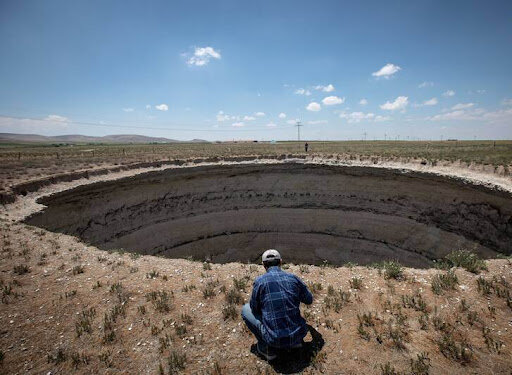Land subsidence worrisome: GSI

TEHRAN – Lands across Iran are vastly subsiding, a threat which is being turned into an acute crisis, Alireza Shahidi, head of the Geological Survey and Mineral Explorations Organization (GSI), has warned.
Land subsidence, a gradual settling or sudden sinking of the Earth's surface due to subsurface movement of earth materials is mainly caused by aquifer-system compaction, drainage, and decomposition of organic soils, underground mining, oil and gas extraction, hydro compaction, natural compaction, sinkholes, and thawing permafrost.
Subsidence results in significant economic losses in the form of structural damage and high maintenance costs. This affects roads and transportation networks, hydraulic infrastructure, sewage systems, buildings, and foundations. The total damage worldwide is estimated at billions of dollars annually.
Some 29 Iranian provinces are currently at risk of subsidence. Stating that the amount of water that penetrates into the ground is not proportional to the amount of water extracted, he said that this has caused the phenomenon of subsidence in all parts of the country except for the provinces of Gilan and Mazandaran.
It is predicted that the provinces of Gilan and Mazandaran will also suffer from subsidence in the coming years, he stated, adding, out of 606 plains in the country, more than 300 are in acute condition and are forbidden to enter.
Referring to the plains of Isfahan province as one of the most critical areas, he stated that the amount of subsidence in Isfahan is about 16 cm and unfortunately the central parts and historical context of the city have been affected.
Stating that the subsidence rate is also very high in the capital city of Tehran, Shahidi said that Tehran suffers from one millimeter of subsidence per day, which is a very large number.
According to the statistics available in the European Union, a subsidence rate of 4 mm means a critical situation, while it reached up to centimeters in Iran.
Major causes
Gholam-Ali Jafarzadeh, head of the National Cartography Center, lamented that some 29 provinces are currently at risk of subsidence.
He named two factors of climate change and human intervention as the most important factors of land subsidence in the country and noted that it is expected that we take measures to reduce the pressure on the environment.
Over the past decades, groundwater exploitation has increased dramatically due to permanent droughts, leading to aquifer depletion.
Shahidi said in May that 80 percent of the groundwater is withdrawn annually in Iran, which outpacing the global rate.
In the whole world, water resources withdrawal is between 3 to 20 percent, and when it reaches 40 to 60 percent which is considered problematic, and it will be a crisis when exceeding 60-80 percent, Shahidi noted.
Over the past decades, some of the aquifer levels dropped by 100 centimeters.
Inefficient irrigation methods in addition to digging illegal wells are the other main causes of groundwater extraction-induced subsidence, as out of 50,000 wells pumping underground water resources in the capital, 30,000 are illegal.
It should be noted that over the next 40 years, the country's temperature will rise by 2.6 degrees on Celsius Scale, which will increase the country's need for more water resources.
FB/MG

Leave a Comment